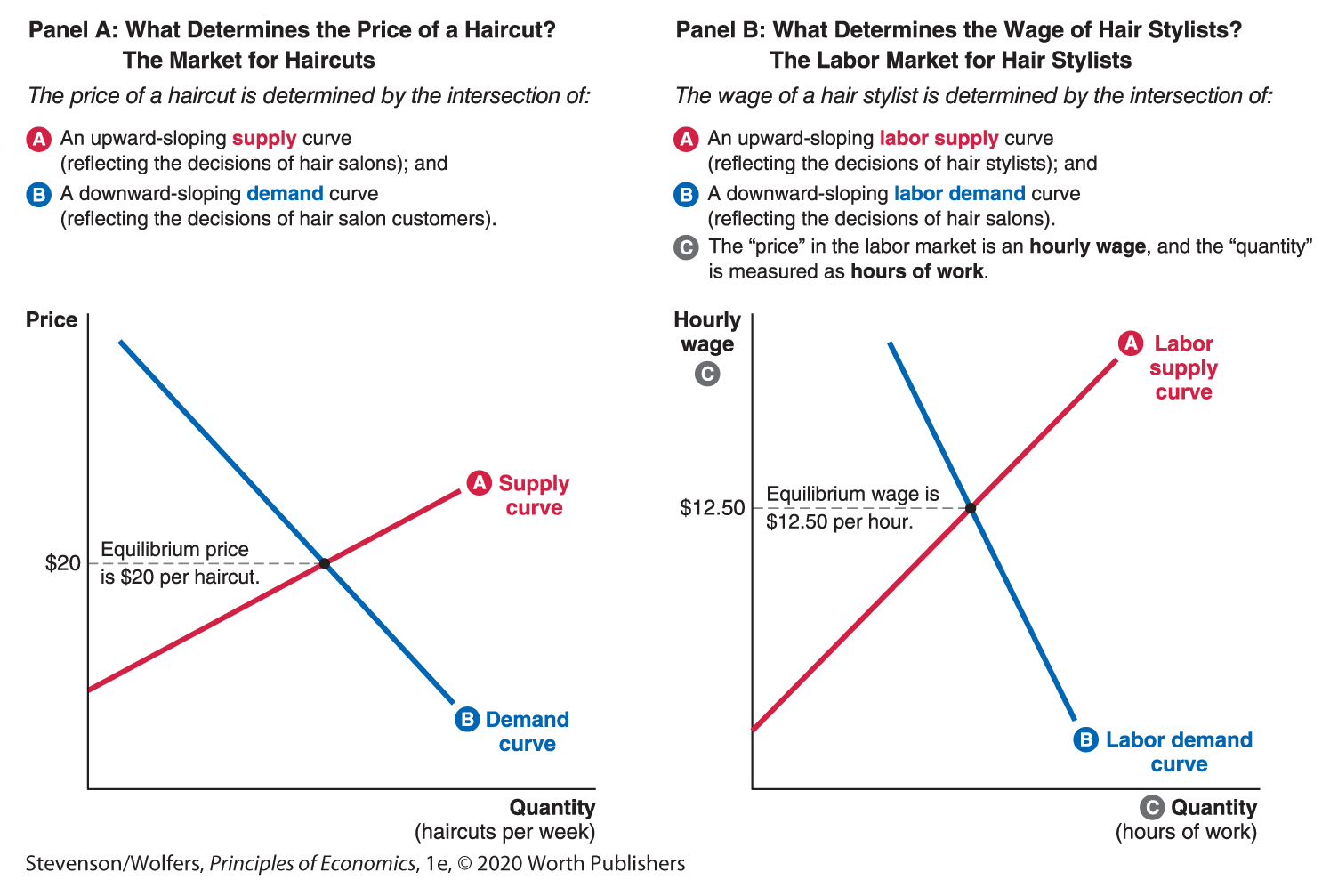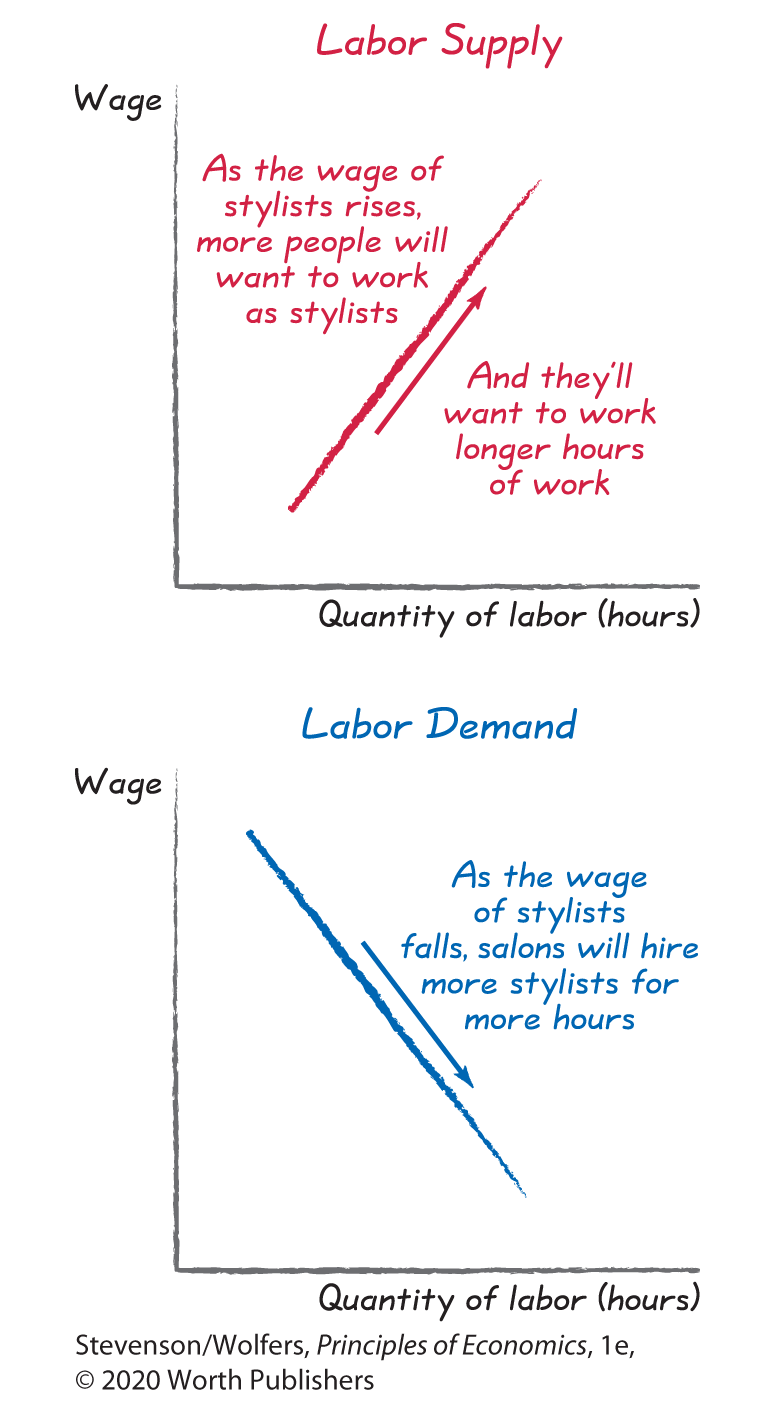11.1 The Labor Market: Supply and Demand at Work
What determines the price of a haircut? That’s easy: supply and demand. Hair salons are suppliers, constantly looking to win new customers. You and I are the demand side, trying to get the best haircut at the best price. The price of a haircut is determined by the intersection of the supply and demand curves, as shown in the left panel of Figure 1.

Figure 1 | The Market for Haircuts and the Labor Market for Hair Stylists

A great hair stylist can give you a great haircut. But what determines their wage?
Okay, next question: What determines the wage paid to the hair stylist who gave you that haircut? Again, it’s all about supply and demand. Instead of the market for haircuts, we need to focus on the labor market for hair stylists, where people can buy or sell an hour of a hair stylist’s time. So the labor market is like any other market, except the units on the price and quantity axes are a bit different. The price of an hour of a hair stylist’s time is their hourly wage. And the quantities a salon buys are their hours of work. The rest should be familiar, as the wage of hair stylists is determined by the intersection of these labor supply and labor demand curves, as shown in the right panel of Figure 1.
Whose choices do these labor supply and labor demand curves represent? In most other markets, we think about businesses as suppliers and ordinary folks like you and me as demanders. But in the labor market, we switch places. As a worker, you’re on the supply side, looking to sell your labor for the highest wage you can get. And businesses are on the demand side, looking to hire the best workers they can find at the lowest price possible.
Let’s think about why the labor supply curve is upward-sloping by analyzing the decisions of Chris, a potential hair stylist. He has to choose whether to supply his labor as a hair stylist or do something else. If the wage for hair stylists is too low, he might take another job—maybe working as a skin care specialist, a veterinary assistant, or receptionist. Or perhaps he doesn’t think it’s worth giving up his time for work. (Notice the opportunity cost principle at work here—he’s asking should I work another hour as a stylist, or what?) If the wage is higher, many hair stylists will work longer hours. (They’re balancing things at the margin, à la the marginal principle.) And the higher the wage, the more people will want to work in hair salons rather than other retail establishments (you can see the interdependence principle here). Taken together, higher wages mean more people like Chris will seek out hair stylist work, either giving up more time to work, or forgoing other work opportunities. (That’s the cost-benefit principle.) Thus, the quantity of hours supplied in the market for hair salons typically rises with the wage. An upward-sloping labor supply curve is just the law of supply, applied to the labor market.

On the demand side, we find hair salons looking to hire hair stylists. If the wage is too high, they’ll hire few hair stylists, which means they’ll sell fewer haircuts. (This is the opportunity cost principle highlighting the consequences of less hiring.) On the other hand, if the wage is lower, salons might also find it profitable to remain open for longer hours—opening earlier in the morning, remaining open later at night, or opening on more days—so they can sell more haircuts. (Again, the cost-benefit principle.) Thus, the quantity of hours demanded in the market for hair stylists is typically higher when the wage is lower. (Managers calculate exactly how many more hours they demand by using the marginal principle.) The downward-sloping labor demand curve is just the law of demand, applied to the labor market. And all of these calculations will also be affected by changes in the cost of other inputs in the hair salon business, like rent for the salon (the interdependence principle).
We’ve described the broad contours of the labor market: Wages and employment are determined by the intersection of the downward-sloping labor demand curve and the upward-sloping labor supply curve. In the rest of this chapter, we’ll focus on how you can apply the core principles of economics to making better decisions in the labor market. As a worker, you’ll want to know how to make good labor supply decisions: how many hours you should work; which occupation to choose; and whether to work or pursue an alternative like more education. And as a future manager, you’ll want to know how to make good labor demand decisions: how many workers you should hire and what wage to pay them. Let’s begin with labor demand.